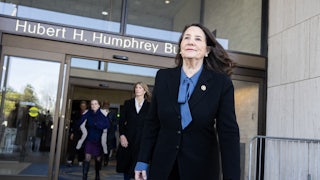At its Summit of the Americas in Los Angeles this week, the Biden administration unveiled a “U.S.-Caribbean Partnership to Address the Climate Crisis 2030,” or PACC 2030, aimed at “strengthening energy security” and “promoting climate adaptation and resilience.” But that partnership seems to be off to a rocky start. Several Caribbean countries had threatened to boycott the event in protest over the White House’s decision to exclude Venezuela, Nicaragua, and Cuba from the summit. Most did end up going and sent delegations to another, less flashy confab halfway across the world—where they promptly castigated wealthier countries for doing little to help them adapt to climate change.
In Bonn, Germany, the U.N. Framework Convention on Climate Change, or UNFCCC, is holding talks until June 16 meant to set the agenda for COP 27, which will take place in Egypt later this year. Speaking on behalf of the Alliance of Small Island States, or AOSIS—a bloc of countries within the UNFCCC process—a delegate from Antigua and Barbuda had some concrete suggestions for what rich nations like the United States could do to help the islands navigate a warming world. Most of those suggestions are ones the U.S. isn’t keen to emphasize.
“In contrast to the estimated nearly $6 trillion that subsidized fossil fuels in 2020, developed countries undershot the USD 100 billion-dollar goal and provided just $19 billion for adaptation,” a delegate from the country reportedly said at the joint plenary session, calling out the slow progress of getting climate finance where it’s needed most. They added that “the data we’ve seen on the number of months to approve an adaptation project is, frankly, embarrassing. It’s no wonder the private sector doesn’t engage in adaptation finance,” per a summary written by Evelyn Teh and Hilary Kung of the Third World Network, a nonprofit research and advocacy organization tracking the talks. And even the money that has materialized mostly hasn’t gone to countries like Antigua and Barbuda that need it most: Just 3 percent of public climate finance delivered under that $100 billion-per-year pledge has gone to small-island developing states, Oxfam has found.
There are just three designated sessions on climate finance set to be held over the course of these two weeks of talks in Bonn, said Saleemul Huq, director of the International Center for Climate Change and Development. Those are part of the Glasgow Dialogue, a three-year process agreed to last year at COP 26 as a means to discuss loss and damage financing, which allows countries to recover from climate-fueled disasters. As I reported then, the dialogue was a compromise measure between richer and poorer countries, who wanted a more concrete financing mechanism. Among the key fights so far in Bonn has been whether loss and damage gets formally discussed at all in Egypt. “Whether or not it gets into the formal agenda of COP 27 remains to be seen,” Huq said, adding that it would be discussed informally either way.
Climate finance operates along a continuum: The more that is spent to reduce (“mitigate”) emissions, the less will be needed to adapt to the effects of rising temperatures. And the better countries can adapt to climate change, the less they will need to recover when disaster strikes. “Loss and damage means the system has failed,” Harjeet Singh, senior adviser at Climate Action Network International, told me. That rich countries are talking explicitly about loss and damage is a recent development and the result of years of pressure at U.N. climate talks from climate-vulnerable countries. As Climate Home News’s Chloé Farand points out, small island states first called to compensate victims of projected sea-level rise 31 years ago. “They’ve gone from not recognizing this is an issue to saying this is an issue that we can talk about,” Singh said of the U.S. “That’s the journey they’ve made. They don’t care whether people are dying, homes are destroyed, or crops are failing.”
Wealthy nations—which bear outsize historical responsibility for the climate crisis—have long argued that existing humanitarian aid and development finance mechanisms are adequate to meet loss and damage needs, and generally push back on demands from developing countries to create a dedicated U.N. financing mechanism like those that already exist for climate change mitigation and adaptation.
Those existing structures leave a lot to be desired, though. A study released this week by Oxfam found that U.N. humanitarian appeals for extreme weather events have grown 800 percent since 2000. Donor nations have, on average, met just 54 percent of those appeals since 2017. Many climate-vulnerable countries are also facing mounting debt and cost-of-living crises and could be forced even deeper into the red to recover from worsening storms and floods. That’s what happened recently in Mozambique, which took out a $118 million International Monetary Fund loan in 2019 after Cyclone Idai claimed over a thousand lives. Overall, some 80 percent of climate finance has come in the form of loans.
Developing countries are pushing to establish a formal body to collect and disperse loss and damage financing at COP 27, and to use the remaining two years of the Glasgow Dialogue to discuss how funds will be raised and distributed. “The dialogue is progressing in a cordial manner. Whether it results in actual finance flows remains to be seen,” Huq told me. He added that the U.S.—which is chairing the Glasgow Dialogue in Bonn—has been in “listening mode” and not especially confrontational but doesn’t appear to have changed its position much since November, when its delegates went to bat to limit conversations about loss and damage or even define what climate finance means.
“Every time you trust them, you feel that you’ve made a mistake,” Singh told me of the U.S. and other wealthy countries. “The whole idea of creating a Glasgow Dialogue was an excuse to stop discussing the [financing] facility there, create something on the outside and then kill it later. We just salvaged it,” he said, noting progress made this week toward getting loss and damage on the agenda for COP 27.
Back at the White House, seemingly disconnected details on PACC 2030 it released on Thursday didn’t make mention of either loss and damage or specific dollar amounts that would flow to the Caribbean. Per a White House fact sheet, the first pillar of this new collaboration is “Improving Access to Development Financing” by increasing U.S. International Development Finance Corporation financing for clean energy, and through partnerships with multilateral development banks, to “unlock access to additional infrastructure financing” in the Caribbean. The second pillar (“Facilitating Clean Energy Project Development and Investment”) looks to “attract private investment in clean energy infrastructure and climate adaptation projects in the region” and will “support the development of bankable infrastructure projects, promote sound regulatory policies, build project pipelines, and facilitate investment opportunities.” Under PACC 2030, the Treasury Department will also reportedly “explore” deferring poor countries’ debt to multilateral development banks and be “open to extending temporary access to World Bank Group resources following extreme events for climate-vulnerable Caribbean countries that have graduated from MDB financial assistance programs.” Treasury will also “work to extend additional support for Latin American and Caribbean countries”—including through the IMF’s recently announced $50 billion, loan-based Resilience and Sustainability Trust—though it made sure to clarify that it would only do so “in the context of meaningful structural reforms.”
All that’s to say that, at least in the Caribbean, debt will continue to play a major role in how the Biden administration approaches climate finance. The distance between America’s presence at the Summit of the Americas and the one in Bonn is emblematic of the White House’s general approach to climate policy: on the one hand, a grand gesture to announce America’s leading role bringing the public and private sector together to usher in a net-zero world; on the other, a preexisting demand from vulnerable countries that the White House would rather not mention on stage.










